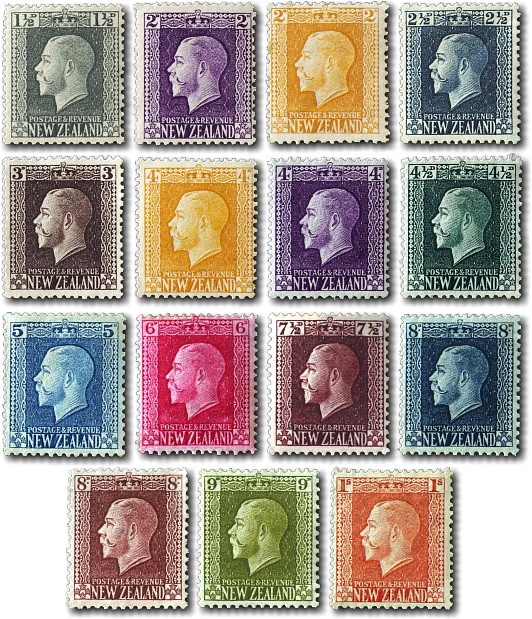
1915 King George V Recess Print
«previous next»

| Cat. | Mint Unhinged | Mint Hinged | Fine Used | |||||
| 1½d | Grey | 27a | $13.50 | $7.20 | $2.70 | |||
| 2d | Violet | 27b | $36.00 | $18.00 | $38.25 | |||
| 2d | Yellow (from 1916) | 27c | $27.00 | $12.60 | $38.25 | |||
| 2½d | Blue | 27d | $45.00 | $18.00 | $13.50 | |||
| 3d | Brown / Chocolate | 27e | $54.00 | $21.60 | $4.50 | |||
| 4d | Yellow | 27f | $27.00 | $13.50 | $81.00 | |||
| 4d | Violet (from 1916) | 27g | $45.00 | $17.00 | $4.50 | |||
| 4½d | Green | 27h | $76.50 | $40.50 | $40.50 | |||
| 5d | Blue (from 1922) | 27i | $54.00 | $31.50 | $3.60 | |||
| 6d | Red | 27j | $36.00 | $18.00 | $2.70 | |||
| 7½d | Brown | 27k | $54.00 | $36.00 | $38.25 | |||
| 8d | Blue (from 1921) | 27l | $54.00 | $31.50 | $67.50 | |||
| 8d | Brown (from 1922) | 27m | $112.50 | $63.00 | $6.75 | |||
| 9d | Olive Green | 27n | $90.00 | $45.00 | $9.00 | |||
| 1/- | Orange | 27o | $90.00 | $45.00 | $4.50 | |||
| Set of 15 | 27p | $773.80 | $397.50 | $337.75 | ||||
Unlike previous issues, recess and surface printings were issued from the start, the surface printings used to reduce printing costs of lower value stamps.
The initial issue contained the 1½d, 2d violet, 2½d, 3d, 4d yellow, 4½d, 6d, 7½d, 9d and 1/- stamps. The 1½d, 4½d and 7½d stamps were new values introduced for parcel post and it was not thought necessary to have 5d and 8d values. All the careful planning came unstuck when a halfpenny tax was imposed on all mail other than newspapers during the First World War. As the new issue did not have 5d or 8d stamps, the Edward VII issue stamps continued in use until 1922 when 5d and 8d recess print stamps were finally introduced. However, within a week of issue of the 8d blue it was realised that the colour was too easily confused with the 2½d stamp, so the stamp was reprinted brown as the 7½d brown stamp had been withdrawn by that stage. This ought to have made the 8d blue stamp very rare, but pressure from stamp collectors forced the post office to continue selling the stamps.
In 1915 the tax on receipts was increased to 2d. The 2d violet stamp was too dark for pen cancellations to show up, and so the colours of the 2d violet and 4d yellow were swapped in 1916. Many used copies of the 4d yellow were cancelled after it was withdrawn and 1915 cancellations are hard to find.

The recess print stamps have a different design to the surface and local print stamps which are listed separately. The recess print stamps (left image) have diagonal shading on George V's face and neck, while the surface print stamps (middle image) have horizontal shading. The background on the surface prints has a clear diagonal pattern, while the recess print stamps have a very fine and complex pattern of alternating arcs with a criss-cross hatching over the top giving the appearance of almost solid shading. The local print (right image) is very coarsely drawn with a diagonal pattern very similar to the surface print stamps, but with rather poorly spaced diagonal shading lines on the face and neck.
Bibliography
The Postage Stamps of New Zealand (Volume I)
Edited by R. J. G. Collins and H. T. M. Fathers B.A. B.Sc.
Published 1938 by The Philatelic Society of New Zealand Incorporated
Pages 293 - 321
The Postage Stamps of New Zealand Volume II
Edited by R. J. G. Collins FRPSNZ and C. W. Watts FRPSNZ
Published 1950 by The Royal Philatelic Society of New Zealand Incorporated
Pages 311 - 314
The Postage Stamps of New Zealand Volume VI
Edited by D. E. G. Naish FRPSNZ and K. J. McNaught FRPSNZ FRPSL
Publsihed 1975 by The Royal Philatelic Society of New Zealand Incorporated
Pages 22 - 24, 358
The Postage Stamps of New Zealand Volume VIII
Edited by B. G. Vincent FRPSNZ
Published 1998 by The Royal Philatelic Society of New Zealand Incorporated (ISSN 0-9597883-1-X)
Pages 710, 749, 750
Catalogue ·
1913 ·
1915 ·
1920 ·
Definitives ·
The Royal Family
Order Form · Currency Converter · Privacy Policy
What to Expect · Contact Us · Links
Order Form · Currency Converter · Privacy Policy
What to Expect · Contact Us · Links
This page was last updated on 16 Sep 2025
All content and images copyright © 2008 - 2025 StampsNZ
All content and images copyright © 2008 - 2025 StampsNZ